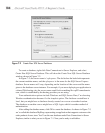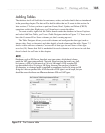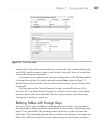
Chapter 7: Working with Data 183
View | Server Explorer or pressing CTRL-ALT-S. Server Explorer, shown in Figure 7-1,
allows you to work with databases, servers, and SharePoint. Servers give you access
to the various types of services for managing an operating system, such as Event Logs,
Performance Counters, and Services. It is very convenient to be able to access these services
in VS during development. For example, if you need to restart an operating system service,
you can do it quickly. SharePoint is out of the scope of this book, but the relevant part of
Server Explorer is the Data Connections section at the top, which you can see in Figure 7-1.
The Data Connections section will have a list of databases that you can select and
work with. Initially, the list will be empty and you must add connections yourself, which
you can do by right-clicking Data Connections and configuring the database settings.
Since the process of connecting to an existing database is similar to the task for creating
a database, I’ll show you how to create a brand new database instead, which is covered in
the next section.
Creating a Database
All of the examples in this chapter will use a database that we will create in this section.
Therefore, we need to create a database to work with. With VS Standard and higher, you
don’t need external tools to create a simple database because there is built-in support for
getting started. That said, there are advanced scenarios where a database administrator
would want to use the SQL Server tools to create the database themselves, meaning that
you would only want to connect to the database they created. For many cases, you can just
create the database yourself to get started.
Figure 7-1 Server Explorer


















